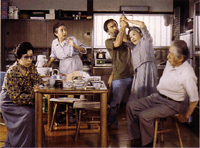On a secluded cottage in the mountains, a retired carpenter and part-time groundskeeper named Rokubei assembles a humble coffin, carefully selects a properly weighted rock from the riverbed, and leaves a last note with the terse inscription “It’s over” scribbled onto the back of a bargain sale flyer before committing suicide – the round rock presumably to be used for driving the nails into his coffin for burial. It is a mystifying and peculiarly pragmatic gesture that intrigues the famous actress, Yoko Morimoto (Haruko Sugimura), who has arrived at her rural summer retreat for a brief holiday and much needed rest before returning to Tokyo to perform in a new theatrical play. Accompanied by the devoted housekeeper, a local villager named Tokoyo (Nobuko Otowa) and Tokoyo’s daughter, the three women take a leisurely stroll through the woods and return to a footbridge overlooking the river where Yoko decides to reserve her own burial stone and store for safekeeping in the house. However, Yoko is soon compelled to re-evaluate her abstract – if not romanticized and dramatic – notions of the process of growing old and death when a former colleague named Tomie (Kyoko Asagiri) pays a visit at the desperate request of Tomie’s husband Tohachiro (Hideo Kanze) who had hoped that the reunion would improve his wife’s diminished mental faculties resulting from the onset of senility.
Directed by a then-octogenarian filmmaker Kaneto Shindo and featuring a principal cast from classic Japanese cinema that includes frequent Ozu and Naruse character actress, Haruko Sugimura (whose distinguished career also includes roles in the films of Kinoshita, Kurosawa, and Mizoguchi) and Shindo’s perennial actress (and wife) Nobuko Otowa, A Last Note is an eccentric, humorous, and poignant tragicomic fable on aging, personal legacy, and mortality. Shindo references Anton Chekhov’s plays both explicitly (in the actresses’ recitation of passages) and implicitly (in Yoko’s personal life mirroring episodes in The Seagull) in order to reinforce an underlying parallel to the author’s idiosyncratically droll narrative tone: the agitated histrionics of a bumbling, escaped prisoner; the surreal interweaving of dreams and haunted memory; the carnivalesque parade that greets Tome and Tohachiro as they disembark from a taxi near a seaside hotel. Similarly, the seeming anachronism of a strangely erotic ancient village wedding ritual (alluding to the behavioral primitiveness of the ‘other Japan’ presented in Shohei Imamura’s cinema) echoes Chekhov’s recurring theme of the immutability of nature and the perpetuation of biological life cycles. By creating a playful, innately whimsical tone as a foil to the film’s thoughtful and somber subject matter, Shindo presents a relevant and vital social indictment against the displacement and marginalization of the elderly – a sentiment reflected in the film’s concluding scene as the image of the legendary actress mobbed by reporters is juxtaposed against a shot of a lone Tokoyo returning to the footbridge – a poetic expression of the determined women’s own defiance against the inevitable.
© Acquarello 2003. All rights reserved.
